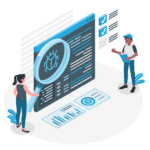9 Steps To Becoming a Great QA Lead
The progression from Senior Tester to Quality Assurance (QA) Lead is something every career software tester aspires to achieve. It’s a natural transition for talented and knowledgeable professionals, and with the increased responsibility comes more compensation and even greater opportunities.
Before advancing to a higher level of accountability, one must acquire an elevated skillset and the enhanced expertise that QA Team Lead positions demand.
Becoming a QA Lead involves much more than possessing a skilled or working familiarity with the tasks required to test software successfully. To be effective, efficient, and exceptional in this position, the individual must acquire all critical abilities not directly related to senior testing.
Do you require highly-qualified software testers for your project? Get in touch with us today!

A Review of Typical QA Lead Responsibilities
During the average project, a Software Quality Assurance Lead draws on various high-level skills relevant to arranging and supervising pre-release product testing. To fulfill the QA Lead responsibilities, one needs to:
- Apply project management to a test team comprising of five or more testers of varying skill levels.
- Have a comprehensive understanding of all aspects of the testing process.
- Participate in the design process to extend knowledge of specific projects.
- Assess and fine-tune the application, solution, or systems involved in testing efforts.
- Identify risks and establish adequate test coverage to validate new features and any needed regression.
- Create and maintain specific and tailored test plans and cases, including oversight or direct automated scripts.
- Define a particular testing scope relevant to the specific project(s).
- Select and manage specific quality assurance processes and testing tools for the assigned task.
- Install and configure appropriate systems and software.
- Implement test scenarios, strategies, and the overall testing process to effectively and quickly reach project goals.
- Execute test cases, including automated or manual testing approaches when necessary.
- Deploy and manage various testing frameworks explicitly geared toward the project at hand.
- Develop, implement, and accurately record specific QA metrics.
- Analyze and identify discovered issues, including final product quality assurance before launch.
- Collaborate with QA and R&D teams to diagnose problems and develop solutions.
- Instill and promote collaborative efforts across the individuals and groups involved in the testing process.
Why Is Quality Assurance Testing Important?
A product’s entire end-user experience depends on completing an effective, efficient, and high-quality test management process. The QA test procedure’s effectiveness from beginning to end determines the final product quality — and the QA Lead remains responsible for this procedure and its methods.
In some sense, every aspect of product quality relies on the individual who develops testing processes specific to that product. This can encompass various characteristics, including UX/UI design or specific coding standards and approaches.
Poorly designed or inadequately functioning products result in a weak end-user experience. Unfortunately, these lackluster experiences drive customers away and result in a revenue loss; in the worst-case scenario, it can even lead to business collapse.
User experience relies on productive QA processes, which ultimately determine a business’s success or failure. Testing is the backbone of any specific product, and it directly affects the ability to attract and retain customers — across the lifecycle of a particular product and for a business in general.
QA Leads are responsible for completing efforts to attain project goals, product quality, and overall enterprise goals. Remember: These QA test strategies prevent problems at or after launch and are the last line of defense a product — and the business developing and marketing it — has against market failure.
How to Become a Strong, Reliable QA Lead

In addition to testing skills, a QA Lead must develop the following mindsets over a successful career. This is about much more than the job description — developing these skills and abilities will drive a career forward in terms of personal objectives and create more substantial opportunities.
It is important to note that the following attitudes — if successfully instilled in a larger team framework — virtually guarantee a higher standard of excellence and genuinely top-tier quality functioning.
1. Become a role model by informing and influencing a positive attitude toward excellence
Building enthusiasm and team morale through non-work activities and recognition are essential to a QA Lead’s work. Likewise, they should encourage and inspire lively and informed discussion about technology — specifically that relating to testing processes and solutions — at every opportunity.
This approach helps identify strengths and weaknesses within a team and delineates areas of possible improvement. An excellent QA Lead should approach the job with the mindset of training an eventual replacement from within their current team. QA Leads should cultivate a positive, forward-thinking attitude, including the principles of learning from past mistakes, establishing a progressive team vision, and pursuing more significant objectives through a team charter.
A strong QA Team Lead knows when to delegate because they understand that appropriate autonomy instills trust and confidence in a team. There is no more effective way of creating a positive team atmosphere than demonstrating authentic leadership and management abilities beyond the scope of a QA Lead position.
2. Report findings in the context of its business value
A good QA Lead focuses on the data communicated to stakeholders as a natural progression of the testing process. Data should be presented in the context of “how” observed application function is detrimental to the objective of the feature or application being developed.
3. Provide information rather than enforcing processes
Discovering as much information as possible about issues uncovered through testing can assist in locating the source of a problem. This information also leads to a greater understanding of how testing services validate and analyze software functions for developers and engineers responsible for the product. This detailed, comprehensive information should be presented in a regular and ongoing fashion.
4. Learn to provide and identify information to make informed decisions versus simple “bug notes.”
Rather than acting as a “gatekeeper” of quality, a QA Team Lead should present findings and recommendations of fault impact on the goal of the application or feature under testing. This approach enables project stakeholders to make informed and accurate decisions. It will also assist developers in isolating and resolving identified errors.
5. Explore and learn about the products being tested
A QA Lead should develop product domain knowledge and work to understand the product’s business objectives. Exploring the product will assist in identifying new features not explicitly conceived or implemented.
The QA Lead can help product owners achieve better workflow designs by gathering testers’ questions during testing. They can equally use those tester questions to assist developers with creating better scenario implementations. QA Leads should also focus on adaptability regarding tools, standards, and processes to maximize the benefits to the project and client.
6. Learn to identify items that slow down testing
Next, QA Leads should possess a strong eye for details to help pinpoint the issues affecting testing. They should also examine how testers use their time on typical work days, paying attention to efforts in configuring the test environment, test data, test prerequisites, and so on, as these are the ideal candidates for reusing and streamlining.
Tracking effort and time on these efforts will help identify the amount and quality of real and direct testing time spent on a project. It can also help improve and streamline testing activities that slow processes and delivery.
7. Recognize the extent that automation offers a project – and identify its limits
Understanding the scope of the automation framework allows a QA Lead to establish a balanced testing approach. This approach helps leverage the benefits of automation testing while balancing the creation, execution, and maintenance effort associated with automation for maximum ROI from testing.
8. Sharpen technical, testing, and business skills
A great QA Lead is always learning. Continuing education as a QA Lead and tester is essential for career longevity and advancement. Therefore, keeping up with industry trends, attending educational training, and researching great leadership styles are all critical activities.
9. Share experiences – the successes and failures
QA Leads who attend events like local testing and quality assurance meetups will create opportunities for enhanced understanding and education — for the individual and other professionals within the field.
Suppose there are no local meetups in a QA Lead’s geographical location… In that case, various forums on Software Testing Club and multiple LinkedIn communities are great places to start networking with other testers.
Even if a QA Lead position isn’t one’s ultimate career goal, mastering these mindsets is essential to becoming the best possible team player and, ultimately, a better tester.
Need to scale your QA team? Learn how we can help.







